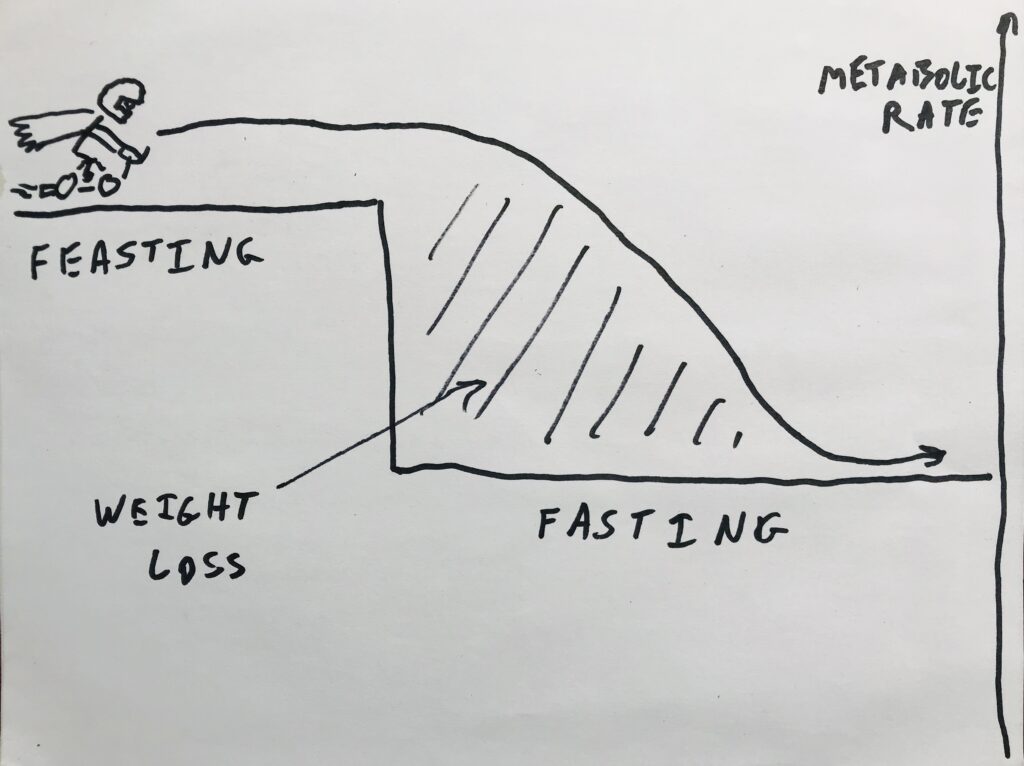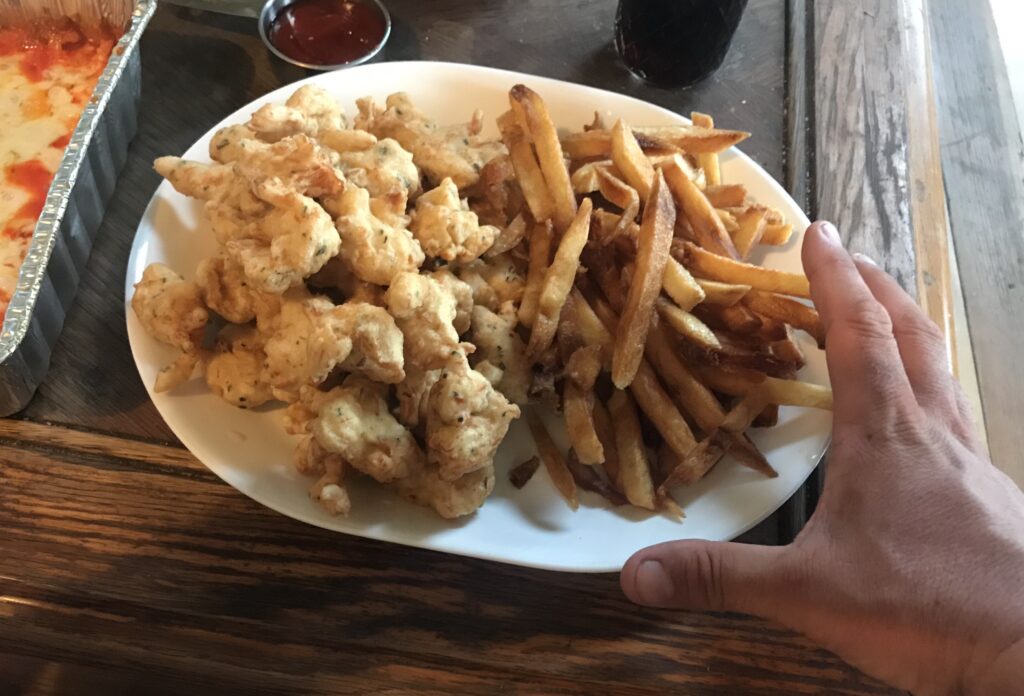- A 48 hour cycle with a single feast meal followed by a day of foods that don’t stimulate insulin
- The feast meal is high in starch and highly saturated long chain fats
- The goal is to increase metabolic rate while fasting by supplying your cells with plentiful fuel

When I initially published The Croissant Diet (TCD) some said that it wasn’t “very scientific”. Some suggested I should “provide more data”. There were many questions about the “best way to us the information I had provided to help someone ‘lose weight'”. Possibly I was just “some kind of freak”. Maybe I was actually just in a “caloric deficit”. Perhaps I should “get a haircut.”
In the intervening months I’ve been able to think and research and I’ve obtained some data gathering devices such as a tape measure. And a skinfold caliper! Also a Keto-Mojo device, which lets me track blood glucose and ketones and breathalyzer to track blood alcohol. And I got blood drawn, and will several more times thanks to Dave Feldman and Siobhan Huggins excellent own your labs project. I did fail to follow my plan not to drink coffee the morning before the blood draw. But it’s not my fault. New York State law says I can’t get blood drawn here without a doctor’s prescription and the nearest Pennsylvania Labcorp is two and a half hours away. So what, I’m suppose to make that drive without coffee?!
I’m also in the process of obtaining a device which will allow me to track my metabolic rate and respiratory quotient. This is the most exciting part but there will be much more about that in a later post.
The feasting mimicking diet is a culmination of my TCD experiment – a proven way to lose weight using starch and highly saturated fat using a “feast” meal alternating with periods of “fasting”. In my case this is a rapid weight loss diet that averages around 2500 calories per day – 3800 calories on feast days and 1200 calories on fast days, which in my case is a mild caloric deficit. Of course, I can’t promise that I’m not some kind of freak and I probably won’t be getting that haircut.
Disclaimer: TCD and Geopolitical Events
This is my third test of TCD concepts. The first test ended up in a painful splitting of ways with my former business partners and career. The second test ended with a global pandemic. I am mildly concerned that a third test will result in an even greater global catastrophe but I feel quite sure the relationship is merely correlative and not causal. If this trial ends in an asteroid impact that instantaneously boils away the seas and vaporizes oxidative life then we’ll know it was causal. But only for a second.
The Feasting Mimicking Diet
I’m a believer in the Calories-in, Calories-Out school of thought only in the sense that I believe in the physical concept of conservation of energy. You have to create a caloric imbalance to lose weight. The obvious thing to do here, eating less, comes with a fatal flaw: you’re body responds to caloric restriction by lowering your Resting Metabolic Rate. A five week 722 calorie per day diet in women was shown to1 reduce Resting Metabolic Rate (RMR) by 23% after five weeks. But even fasting for 24 hours can reduce RMR by around 10%2.
Conversely, forced overfeeding can increase metabolic rate by at least 14%2. Yet there are surprisingly few rapid weight loss diets that ask you to begin by stuffing yourself with a highly palatable, very high energy density meal comprised of equal parts of fat and starch with protein until you literally can’t take another bite. For some reason, all diets want to focus on reducing calories in. This one focuses on maximizing calories out.
Let’s do the math – your metabolic rate in the feasted state could be (114% or 1.14 divided by 77% {100%-23%} or 0.77) 48% higher in the feasted versus the fasted state. Who wants to live in the fasted state?!
So the kernel of my idea is this: we trick our metabolism into thinking that we are feasting but then we in fact fast. It’s a bait and switch. We feast which revs our metabolic engine and then we just let it go on burning.

How do our cells KNOW whether we are feasting or fasting? Dave Feldman recently spoke of the blood as a “Buffet” at his presentation of The Lipid Energy Model at Stanford. I like the analogy. Our cells are lined up at the buffet. From the perspective of a cell standing at the buffet table, if the buffet is full of the cells preferred types of energy, it is feast time.
The blood can carry lots of different types of energy. The ones I know about are fat – which can travel around as Chylomicrons, VLDL or Free Fatty acids AKA Non-Esterified Fatty Acids (NEFA) – glucose, fructose, amino acids, alcohol and ketones. Each of these fuel sources are preferred by different cell types and many of them get into cells by passive diffusion, which is to say that the more there is in the blood, the faster they move into cells. It seems logical to think that cells who see high amounts of their preferred fuel types at the buffet table think this is a good time to go about spending energy doing whatever it is that cells do when there is energy around.
The Feast and The Fast
The mechanism we use to trick our cells into thinking that we are feasting is feasting. But it has to be the right feast. The focus needs to be on consuming a massive amount of saturated fat while avoiding unsaturated fat. The best, most palatable ways to do this is to absorb the saturated fat into starch. Of course, combining fat, starch and protein will spike insulin but only for 2 hours out of every 48 so overall this dietary approach leads to very low exposure to insulin. Yet the two hours insulin DOES spike is when amino acids will be shuttled into cells for rebuilding proteins, so I think it’s actually helpful.
Firebrand Meats Low-PUFA Pork CSA
Bacon without the corn oil! Almost all american pork – conventional, organic, pastured or otherwise, is high in polyunsaturated fats. Firebrand Meats is the first American meat company specializing in making low-PUFA pork. It is a subscription based service that is shipping to all 48 continental states. It’s based on a CSA (community supported agriculture) model, which means we need a bunch of folks to sign up to get production started.
The feast meal I am using to perform the experiment is buffalo pancake chicken with fat bomb fries. It’s delicious. I see no reason not to eat the most delicious things while losing weight. Keep an eye on this blog, recipes soon to follow. The sources of fat are grassfed beef suet, stearic-acid enhanced butter, sour cream and cheese. I have weighed out every component of the test meal including the fryer pot before and after so I can track macros exactly. I can consume 2800 calories of this meal in a 30 minute window without actually bursting. Barely. The last 500 calories are a struggle but I do what I can for science. The macros of the meal are 190g fat, 190g starch and 108g protein. Of course I consume the meal with ample wine and that adds another 1000 calories to the feast day. Perhaps 1200.

The concept of the fast day is: don’t spike insulin. Avoid starch and protein. Things you can consume include dry alcohol such as wine or spirits, pure fats like cream, butter or suet. Perhaps some low starch vegetables or bone broth. Cream of mushroom or celery soup without flour is an option. I’ll post a recipe soon for a divine cucumber fat bomb salad. In my case, though, I just drink wine on the fast days. Wine Fasting.
Setting The Buffet Table
Eating lots of long chain fats causes acute insulin resistance in your fat cells. To understand the science behind this read The ROS Theory of Obesity. Insulin is a switch that tells your fat cells to stop releasing Free Fatty Acids into the buffet and start pulling fats out of it. Having lots of Free Fatty Acids on the buffet table makes your muscle cells insulin resistant, which stops them from pulling glucose off of the buffet. The starch is ideally largely converted into glycogen by the liver, which can release it as glucose as needed over the next 48 hours. If everything works, for as long as 42 hours after the feast you will have high circulating levels of blood glucose, Free Fatty Acids, possibly amino acids, plus alcohol and/or ketones at times. The feast meal provides a full buffet to the cells.
Peter at hyperlipid recently speculated that “hunger might be a simple matter of the energy content of the blood supplying the hypothalamus”. In my case this appears to be true. After consuming this feast I CAN’T EAT. even 24 hours later I’m not really hungry. I’m a chef and I love food and eating, so this is still a new experience to me. Halfway through the first fast day my anxiety changed from making it through the fast to being concerned that I wouldn’t hungry for the next feast!
My blood glucose was at 110 mg/dL the morning after the feast and stayed high throughout the fast day. Only this morning 40 hours after the feast did my blood glucose drop to a more normal level of 94. As part of the experiment I will be getting blood drawn after both a feast and fast day to check my Free Fatty Acid levels. I’ve noticed an inverse correlation between ketones and alcohol. Within fifteen minutes of drinking wine my ketone levels plunge. By the next morning they are on the rise again, peaking in late afternoon. At five PM the day after the feast, my ketone level was 0.5 mmol/L on my Keto-Mojo device. It’s now 1 PM the afternoon of the feast day, I’ve eaten nothing, my ketones are up to 1.0 and my blood glucose is down to 92. My hunger started to return sometime around noon, I’m getting excited for the next feast!
It seems that if I have high Free Fatty Acids, high blood glucose and either alcohol or ketones available hunger simply isn’t an issue.
Check Back In!
I’ll be posting dietary progress, recipes, blood test numbers. There will be some cool articles about metabolic rate. I’m going to feast now.
- 1.van Dale D, Saris WH. Repetitive weight loss and weight regain: effects on weight reduction, resting metabolic rate, and lipolytic activity before and after exercise and/or diet treatment. The American Journal of Clinical Nutrition. Published online March 1, 1989:409-416. doi:10.1093/ajcn/49.3.409
- 2.Schlögl M, Piaggi P, Pannacciuli N, Bonfiglio SM, Krakoff J, Thearle MS. Energy Expenditure Responses to Fasting and Overfeeding Identify Phenotypes Associated With Weight Change. Diabetes. Published online July 16, 2015:3680-3689. doi:10.2337/db15-0382

Timothy Ferris has a variation of this in his 4-Hour Body book. Slow Carb Diet is 6 days of low carb routine meals combined with a Cheat day once per week, ie Dieters Gone Wild. I have not done this in a while but you have me thinking about trying it again, thanks.
Sounds divine! Can’t wait for an update!
Get a haircut NO
put on a shirt YES
Haha! Honestly I’m super self-conscious about how I look without a shirt on, publishing that photo was stretch for me!
The saga continues! So glad to see an update, your blog is fantastic and informative. After some good gains on a carnivore-ish diet, my fat loss stalled and reversed, but dropping pork and chicken (1-2 bags pork rinds every day…) based on your writings, seems to have reversed the reversal. Looking forward to the low-PUFA pork. Wish I could do the super-high-starch thing but the glucose/insulin spike unfortunately seems to trigger my afib.
You need to give us more content Brad!
Working on it!
Hmm this approach kinda reminds me few things:
– Leangains protocol – high protein intake and high calories on training days and low calories on non-training days
– Protocols for weight loss by Lyle McDonald eg. Going low carb for most part of the week then high carb only refeeds(leptin stuff).
Also, Kiefer’s CarbNite goes in the same direction.
Way to go Brad!
I’m super excited about this.
What are your thoughts on the carnivore variaty of the feasting/fasting?
Same ratio fat and protein, omit the starch calories, or up the fat calories to make up for the missing starch? Or up the protein maybe? You have to make it through the 48 hrs without hunger.
And difference between the guys and the gals doesn’t matter maybe as long as everyone eats ’till they burst?
In principle it should be the same. One concern I would have is that I’ve come to believe there is something about the rise in BG over the first 24 hours that helps with hunger. OTOH perhaps without the BG, ketones would be higher, so I’m not sure.
And yeah, I’d say just eat until you can’t imagine getting down another bite!
Any worries about blood sugar being elevated for extended periods? Maybe that is needed to keep hunger at bay? In previous blog posts people have reported blood sugar lowering effects so I am interested how this plays out. I have started to rotate this way of eating in with a carnivore diet and psychologically it is just what I need. Only downside seems to be a little acid reflux but nothing major.
To date what I’ve seen is this: My BG stays elevated for around 24 hours post-feast and then drops. By the morning of the fast day my BG is as low as I’ve ever seen it. After two or three cycles my BG stays lower during the entire 48 hour cycle than it was for the first cycle.
Brad,
I really think you are on to something.. this dysregulation of appetite by Omega 6 /PUFAs and even MUFAs.
In combo with the metabolic down regulation (preventing the uncoupling of the mitochondria and heat wastage) when saturated fat (in the form of stearic acid/ suet etc) is removed from the diet.
The promotion of insulin sensitive fat cells (thank you Omega 6) in an otherwise insulin resistant body.
The blood Buffet is is quickly shuttled in to the insulin sensitive fat cells leading to the fatal combination of a slowed metabolism and constant hunger…and fat hypertrophy..
half the story is the insulin but you may have uncovered (along side Peter at Hyperlipid) appetite regulation and metabolic upregulation is the other …
Result a diet that sates whilst signalling mitochondrial up regulation and insulin sensitivity in the muscular skeletal system and NOT the fat cells.. GENIUS… Good luck and I am following with interest
Agree with dm and add the “Warrior Diet” and the “Carb Nite” solution.
I actually do a kind of hybrid between LeanGains, Warrior and Carb Nite:
Gym: Tues, Thurs, Sat, Sun. Heavy compounds, relatively low volume but high intensity (e.g. double bodyweight squats for reps, 2.5x BW DL for reps, weighted pullups)
Weekdays:
Gym days = some carbs (e.g. 100g)
Rest Days = almost no carbs, calorie deficit.
Weekends = loads of carbs.
All days = eating window of ~7pm – 10pm.
Basically, I get the deficit during the week (e.g. 700 cals deficit over 5 days) and then refeed at the weekend.
I find this the easiest, most enjoyable way to diet.
If I want to maintain or gain muscle, I just up the calories during the week.
All the food is Food, as Peter @ hyperlipid would says – i.e. no vegetable oils and nothing that’s not a plant or animal.
The only exception is pizza, but that’s shop-bought frozen and very basic – I add my own mountain of rocket and prosciutto.
Cool.
Brad.
What times of the days are your feast, fast meals?
Or is it just 48 hrs between feasting?
Thanks – Bob L.
I do the feasts in the late afternoon/evening. Between about 4 and 6 PM depending on the day.
If I do it too late It’s hard to sleep. And I don’t want to do it earlier because I’m unproductive after a big meal.
Hey Brad,
Are you tracking your blood pressure through all of this? Curious what you’re seeing if you are.
I’m not. I probably should be?